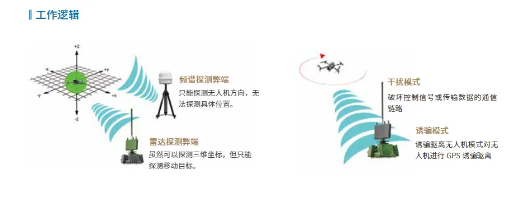Anti-drone Technology: Principles, Current Status, and Future Development Trends - A Comprehensive Analysis
Release time:
2025-06-04
With the widespread application of UAVs in civilian and other fields, "low, small, slow" targets (low-altitude, slow-moving, small flying targets) have become a major threat to security systems. Counter-UAV technology is now an important means to ensure the safety of national, public, and critical infrastructure.
This article systematically analyzes the current development status, technical principles, and future development directions of some counter-UAV technologies.

(Image from the internet, if there is any infringement, please contact the editor to delete)
Counter-UAV technology, also known as UAV counter-measure systems or C-UAS (Counter-Unmanned Aircraft Systems), refers to a system or device that legally and safely detects, identifies, interferes with, decoys, and controls UAVs.
Modern counter-UAV systems typically adopt a multi-layered defense architecture, integrating multiple functional modules such as detection, identification, tracking, and neutralization. The system can provide 360-degree all-round protection under various weather conditions, with a detection range of over 2 kilometers.
Radar Detection Technology
The core principle of radar is based on the emission and reflection of electromagnetic waves. The system emits electromagnetic waves of specific frequencies. When the beam encounters a target, reflection occurs. By receiving and analyzing these reflected signals, key information such as the target's distance, azimuth, altitude, and speed can be precisely obtained, providing accurate guidance for subsequent interception.
Counter-UAV technology utilizes means such as radar detection, radio interference, and photoelectric identification to monitor, identify, and strike UAVs, effectively curbing their misuse and illegal activities.
Modern counter-UAV radar systems mainly include pulse Doppler radar, continuous wave radar, and frequency-modulated continuous wave radar.

High-resolution radars are specifically optimized for drone detection, capable of identifying commercial drones with small radar cross-sections. Since the radar cross-section of commercial drones is similar to that of birds, advanced radar systems use machine learning and artificial intelligence to distinguish between drones and other flying objects.
Phased Array System (Azimuth Mechanical Scan + Elevation Phase Scan)

Azimuth Mechanical Scan + Elevation Phase Scan Radar is a high-performance, highly reliable three-coordinate radar detection equipment, mainly used for detecting and locating low-altitude aircraft targets.
This radar operates using a phased array system, achieving target detection and tracking through azimuth mechanical scanning and elevation phase scanning, providing real-time and accurate target track information, including spatial position, speed, and other data. It can be widely applied in places such as prisons, airports, and bases, providing strong technical support for security work. This radar has the following characteristics:
Multi-dimensional Precise Detection: Capable of multi-dimensional precise detection of distance, azimuth, height, and speed for low-altitude and ultra-low-altitude targets.
High Positioning Accuracy: Possesses high detection capability, high adaptability, and low false alarm rate for ultra-low-altitude, slow-moving small targets.
All-weather Use: Enables all-weather unattended operation, and avoids electromagnetic radiation interference to operators.
Long Detection Range: Depending on the product, the maximum detection range can exceed 25 kilometers, allowing for the detection and tracking of long-distance targets.
Strong Adaptability: Lightweight and miniaturized design, allowing for temporary setup or fixed deployment according to different mission requirements, with quick and easy installation.
Counter-UAV Systems

Soft Kill Technology
Soft kill technology interferes with UAV systems through non-physical means, while hard kill technology directly destroys targets through physical means.
Jamming Technology
RF jamming is currently the most widely used countermeasure. It blocks the communication link between a drone and its operator by emitting interference signals on the same frequency band as the drone's communication. Modern jamming equipment typically employs dynamic frequency jamming and wideband jamming to counter the drone's frequency hopping technology.

Developed by Wuhan Rekoda Technology Co., Ltd. Owl Omni-directional Anti-Drone System Within 2-3.5 Km, it employs dual detection and identification via radar and spectrum. Within 1 KM, it uses dual decoy and radio interference. With high-gain directional antennas, a single-channel power of 25-30 watts, and concentrated energy, the precise interference range is 1~5 kilometers. The system automatically executes defense plans, activating strike or navigation deception measures upon encountering unauthorized drones to ensure regional security.
Deception System
By emitting false navigation signals, it interferes with the drone's navigation system, causing it to misjudge its own position or unable to navigate correctly. This technology can force drones to deviate from their predetermined routes or land in designated areas.

Wuhan Rekoda Technology Co., Ltd.'s Hai Dong Qing Directional Anti-Drone System Integrated Photoelectric 、 Radar 、 Jamming and Navigation Deception and spectrum monitoring technologies, forming a powerful defense entity.
Dual Linkage Disposal
Hai Dong Qing Directional Anti-Drone System Combines navigation deception and radio suppression jamming to effectively complement deception and jamming within the warning and core zones, forcing drones to immediately land, hover, or return.
Radar + Spectrum + Photoelectric Triple Linkage
Hai Dong Qing Directional Anti-Drone System The detection system consists of spectrum detection, radar detection, and photoelectric tracking, effectively complementing active and passive detection methods to achieve efficient UAV monitoring and tracking within a 5-kilometer range.
Hard Kill Technology
In addition to the above-mentioned soft-kill technologies, there are also methods to intercept or destroy "black flying" drones through laser weapon systems, kinetic energy interception technology, hard high-power microwave weapon technology, and hard nuclear physics interception technology.
Challenges and Future Development Directions
The development of anti-drone systems in the future faces many challenges, such as the rise of AI, upgrades in drone technology, and legal regulatory restrictions.
In the future, anti-drone systems are expected to develop towards intelligence and automation, introducing advanced algorithms and artificial intelligence to quickly and accurately respond to complex situations; to move towards multi-functional integration, integrating different countermeasures to flexibly respond to various drone threats; and to strive for portability and concealment, facilitating rapid deployment and immediate use when needed.
Driven by both the iteration of drone technology and the upgrading of security needs, a new generation of radar systems, represented by the Le Ke Da XW/SR226 series, is reshaping the anti-drone defense system through "technological innovation + scenario adaptation." From airport airspace to border security, high-precision radar detection has become a core cornerstone in building a national low-altitude security network. In the future, it will be deeply integrated with directed energy weapons and AI decision-making systems to provide more reliable technical support for smart cities and national defense security.









